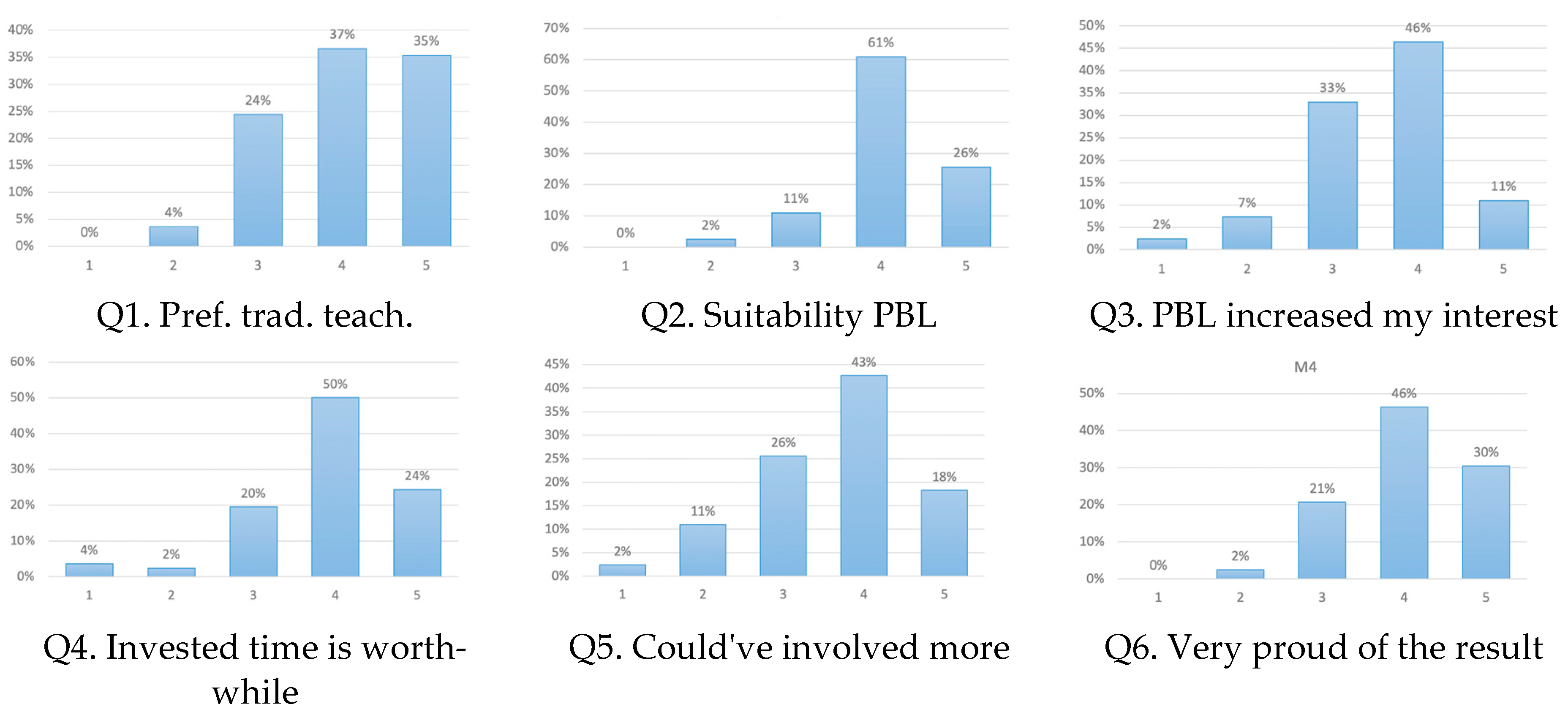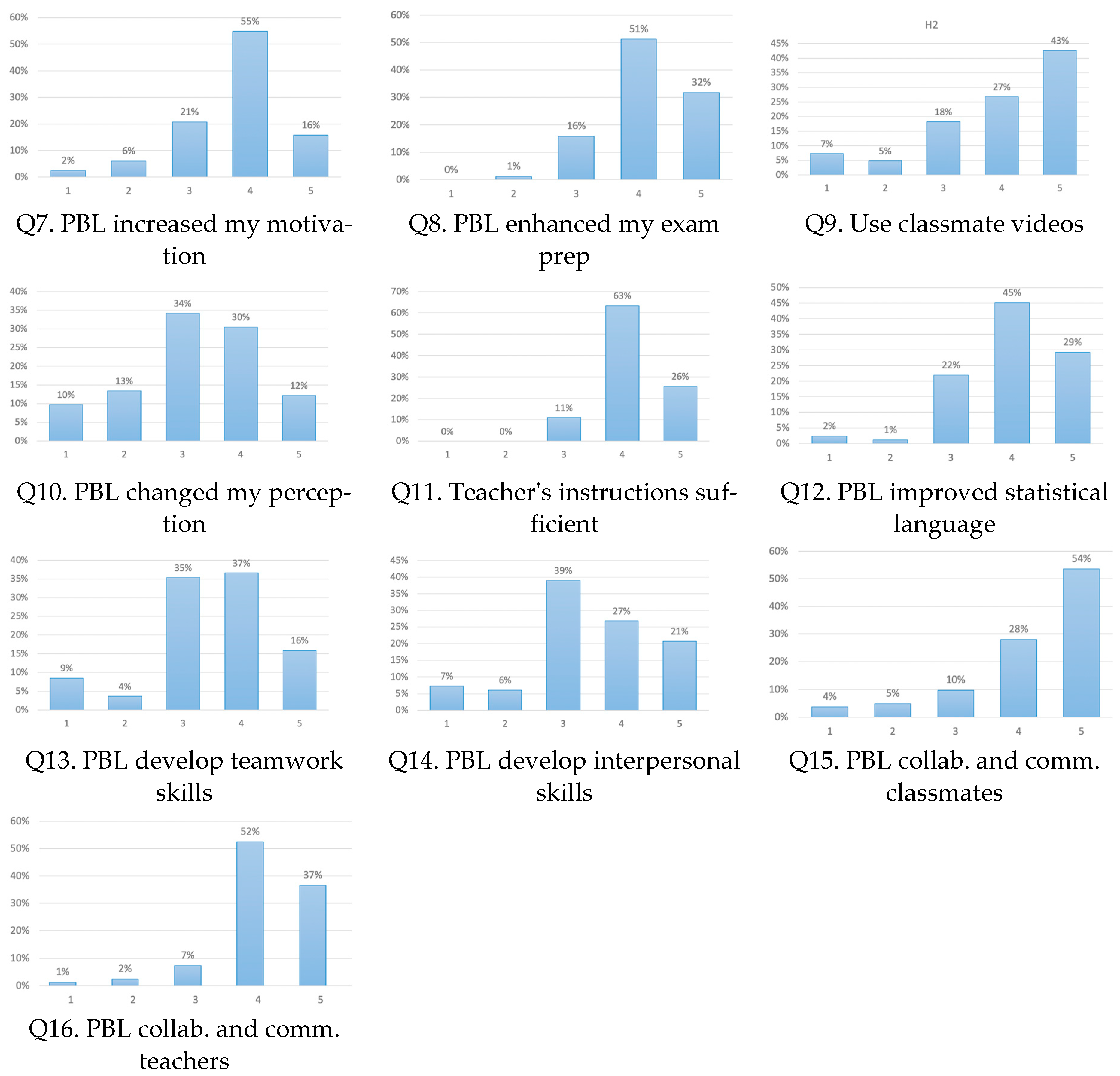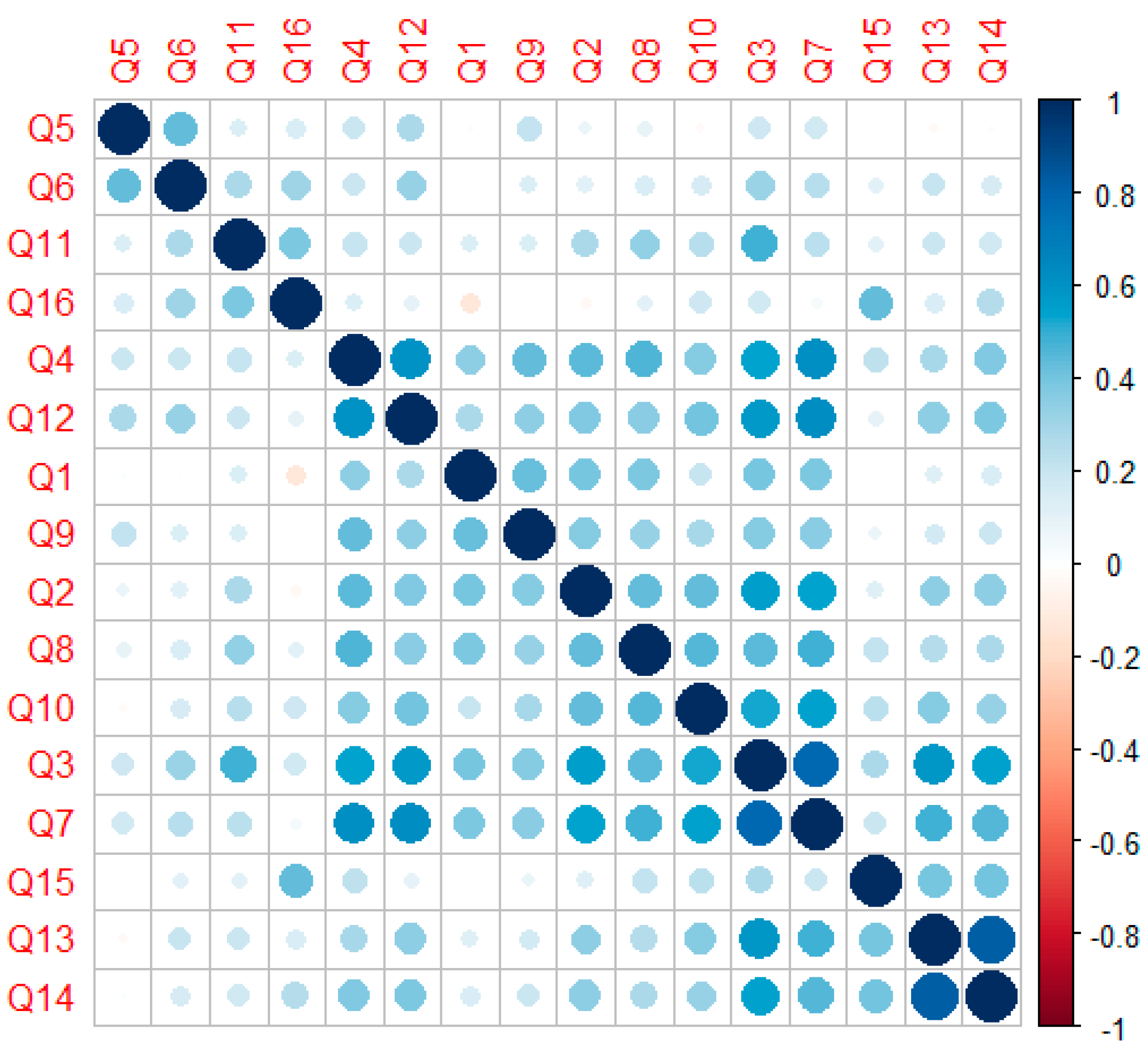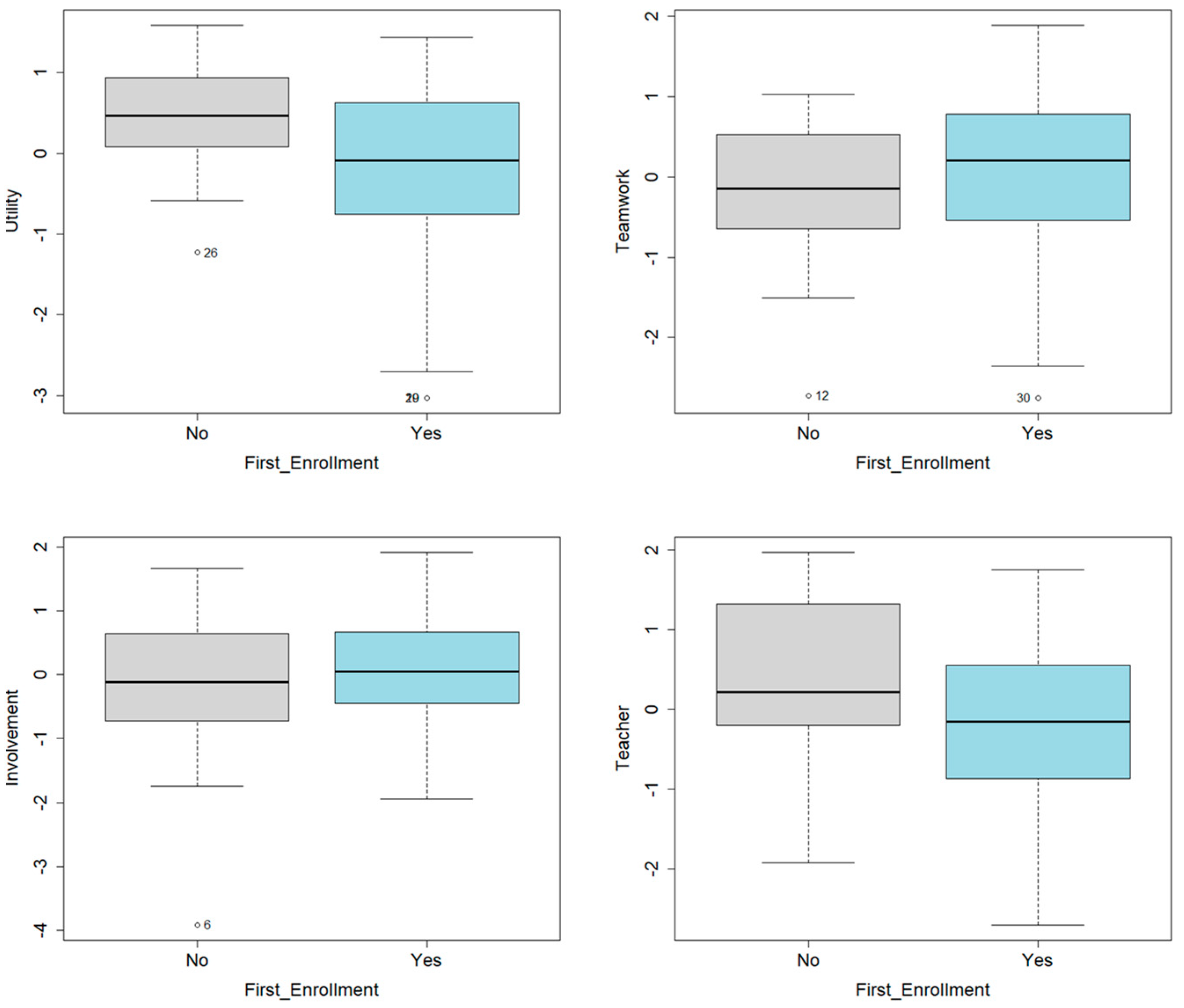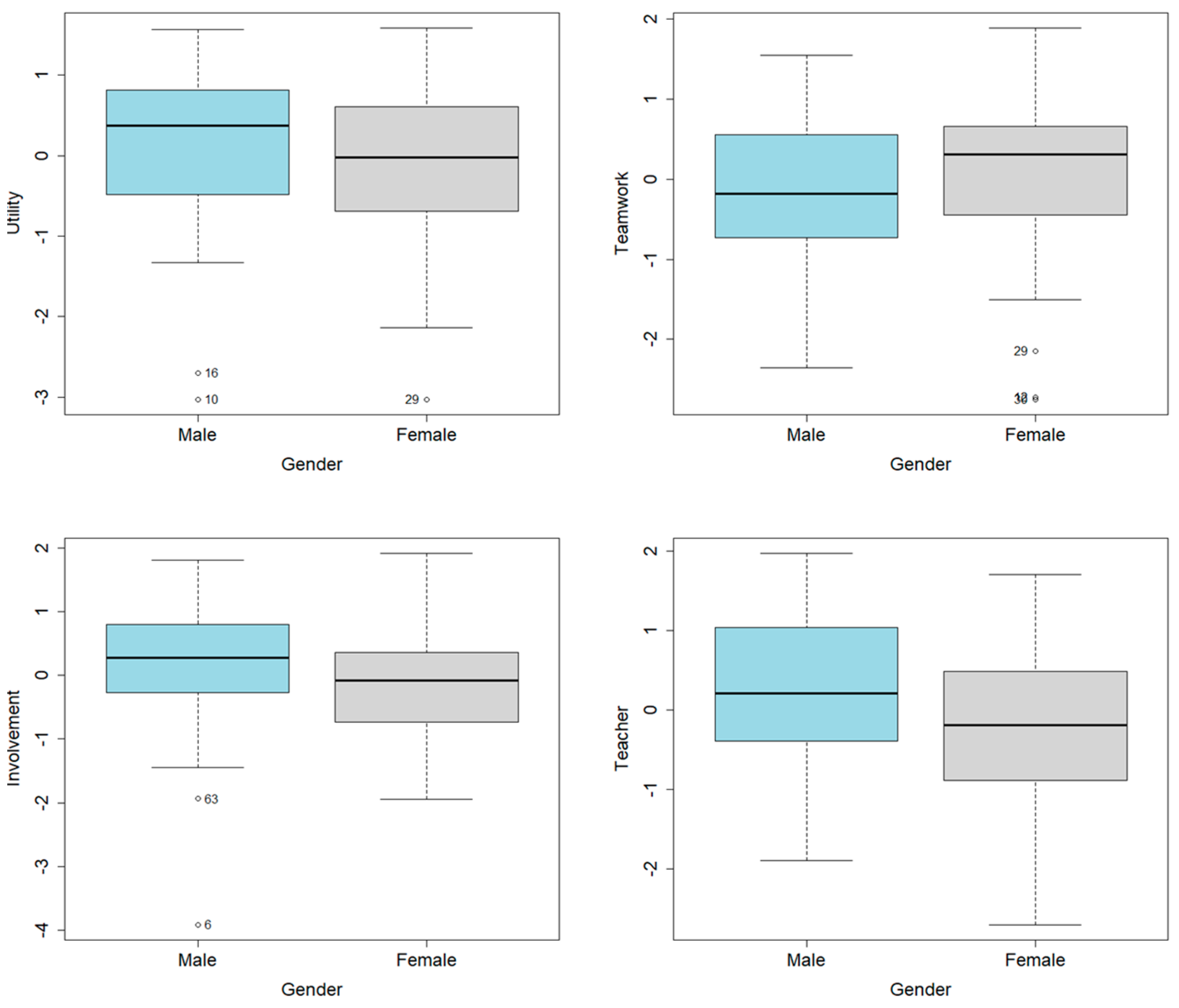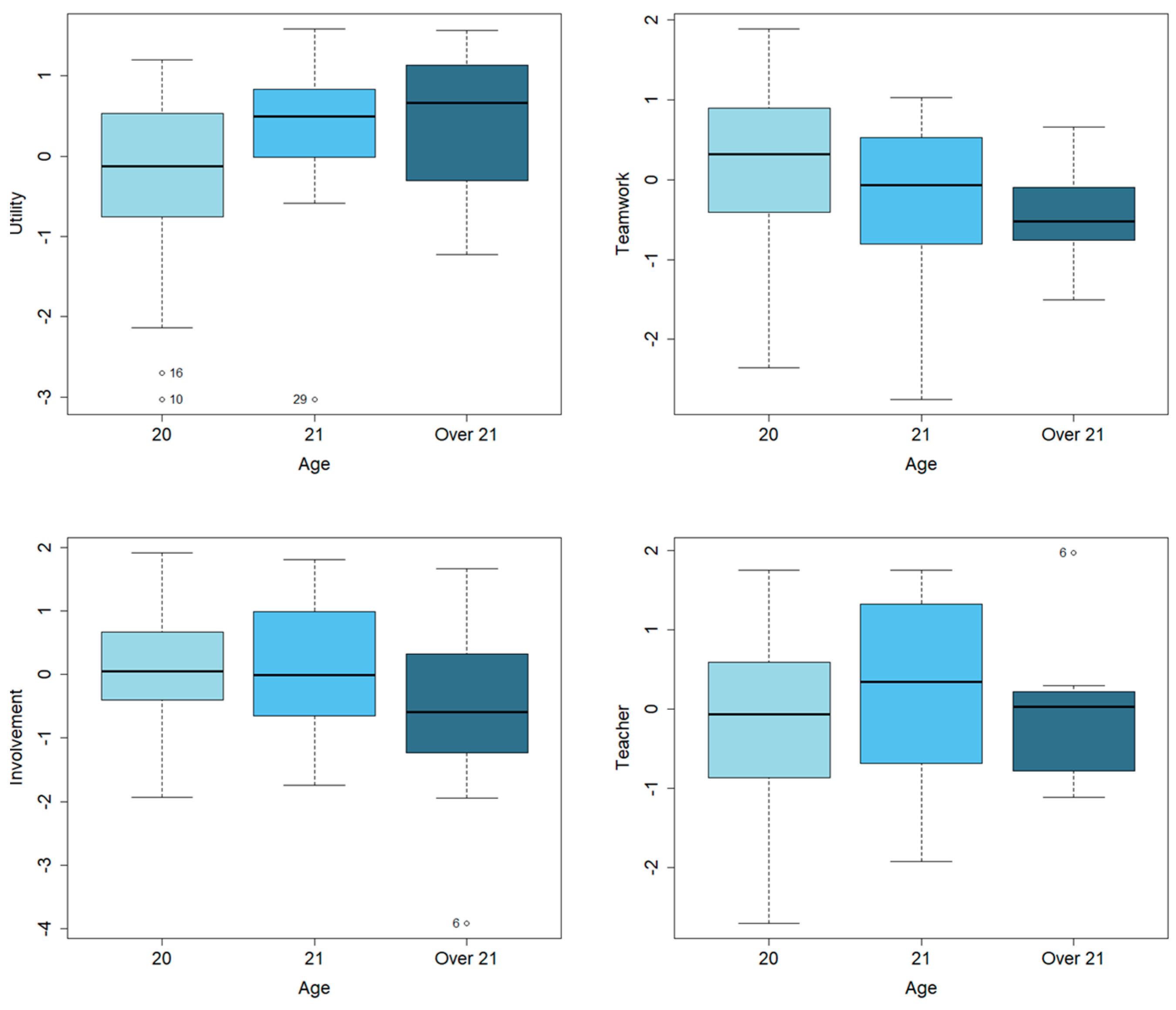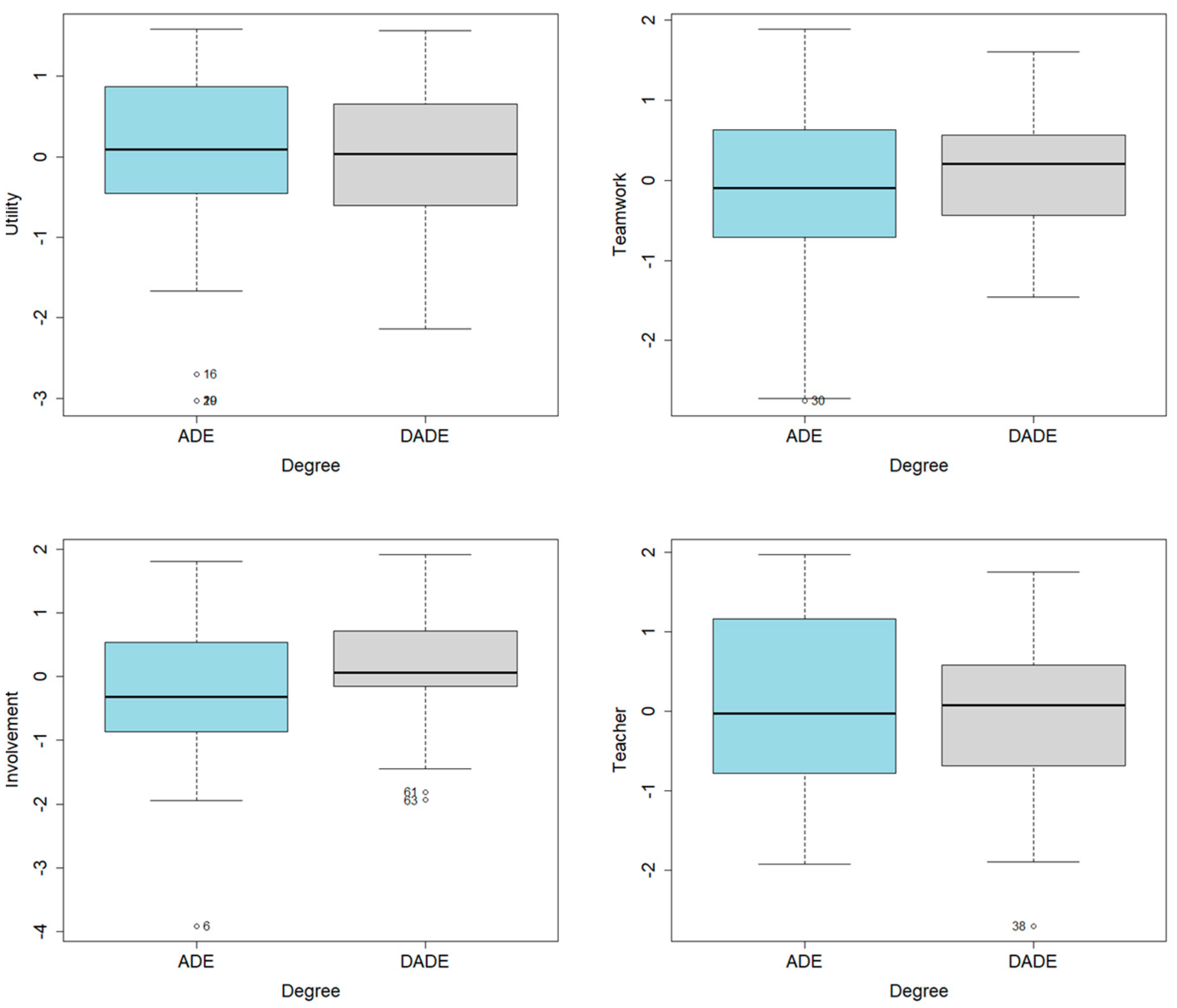The results of our study provide compelling evidence supporting the acceptance of the hypotheses formulated in this research. Through a comprehensive analysis of the data collected from students enrolled in the ADE and DADE degrees at the University of Zaragoza, we have observed significant positive outcomes attributed to the implementation of the PBL approach, particularly when supplemented with video resources, in teaching Statistics II. Below, we discuss these findings in detail.
4.1. Hypotheses Discussion
If we analyse students’ perceptions in the learning process (KI1), our results show that 71% of students increased their motivation towards the subject, and 61% of students indicated a high level of commitment to the project. Furthermore, most participants (87%) perceived PBL as suitable for learning statistics. This aligns with the initial goal of the project to motivate and support students who may face challenges in this subject.
Therefore, according to these findings, our research supports H1. The results demonstrate that the PBL methodology and the integration of video resources were positively perceived by students compared to traditional educational approaches. This positivity manifested in increased motivation towards the subject, heightened commitment to the project, and an overall recognition of the suitability of PBL for learning statistics. Our analysis also revealed a positive correlation between students’ perceived utility of the project and their active engagement in the learning process. This positive attitude is partly attributed to the collaborative and applied nature of the PBL approach, which fosters proactive student involvement in addressing real-world problems.
Notably, our study identified that older male students exhibited a greater appreciation for the project’s utility, indicating potential influences of age and gender on students’ perceptions. Additionally, the project’s benefits were particularly pronounced for repeating students, facilitating deeper comprehension of statistical concepts, and reinforcing our initial aim to support and motivate students facing academic challenges. Therefore, our findings underscore the significance of adapting teaching strategies to meet the diverse needs of student populations, emphasising the necessity for tailored instructional approaches that accommodate varied learning styles, ages, and genders. By prioritising adaptable teaching methods, educators can create inclusive learning environments conducive to sustainable educational practices. Future research endeavours could delve deeper into exploring the effectiveness of such strategies in enhancing student engagement across different profile groups, contributing to the ongoing discourse on innovative pedagogical practices within the realm of sustainable education and approaches.
With respect to the development of practical skills and transferable competencies in statistics (KI2), we observe that 53% of students perceived positively that the project had helped them to develop their teamwork skills (35% were neutral towards this statement). In addition, the methodology used was perceived very positively in terms of improving communication between students, as 82% felt that they had improved in this aspect. This result is consistent with the one obtained by Najah et al. [
23]. The authors analysed how the implementation of PBL through lesson study impacted oral communication skills; they found that there was a 5% improvement.
Similar results were obtained in terms of statistical language improvement. Our aim was for students to understand and know how to apply the statistical concepts studied in the course by solving real problems in the field of Business Administration and Management (KI3). In total, 74% of the participants perceived how the methodology used facilitated the learning of statistical language. This result can be attributed to the tutoring that was carried out with the students. Teachers not only show students how to solve problems but also how to communicate their mathematical (statistical) thinking to peers, in a similar way to the creative process developed in [
24]. In addition, the correction that the teachers carried out through the editing of the video that the students presented that was available for the whole class can justify this observed improvement.
The results also highlighted a gender-based difference in terms of teamwork skills, with males exhibiting a higher level of involvement in the project. This might be linked to a potential performance gap between male and female students in Statistics II. The project’s ability to engage male students more actively suggests its effectiveness at addressing varying learning needs based on gender.
Therefore, our findings provide robust support for H2 regarding the development of practical skills and transferable competencies in statistics. Specifically, our study reveals a significant enhancement in terms of teamwork and communication skills among students engaged in PBL activities supplemented by video resources. This positive outcome underscores the efficacy of PBL in fostering the acquisition of crucial skill sets essential for success in Statistics II.
Moreover, our research highlights that the use of videos not only facilitates students’ understanding of statistical concepts but also cultivates their ability to present and explain these concepts and reports to their peers effectively. Through the process of creating and designing video content, students develop proficiency in articulating complex ideas, structuring information logically, and engaging their audience visually. This approach not only enhances students’ statistical competency but also nurtures their creativity, digital literacy, and presentation skills, which are highly valued in both academic and professional contexts.
Furthermore, the integration of statistical language within the context of problem-solving scenarios provides students with a practical understanding of how statistical concepts are applied in real-world situations. By interpreting statistical language within the framework of the specific problems they are solving, students learn to communicate effectively, using the appropriate statistical terminology to convey their analyses and findings accurately.
Our study makes a contribution in terms of offering concrete evidence of the effectiveness of integrating PBL and video resources to enhance specific competencies vital for students’ academic and professional growth in the field of statistics. By elucidating the tangible benefits of such pedagogical approaches, our research provides actionable insights for educators seeking to optimise student learning outcomes in similar courses.
Another fundamental of PBL is the promotion of peer learning through small group discussions, as argued by the developer of the methodology [
25]. If we analyse the dynamics of collaboration and communication (KI4) between the students and the teacher, the results display that 89% of the participants showed smooth collaboration and communication with the teacher throughout the project. The analysis also revealed that males repeating the course tended to have higher scores in terms of communication with teachers. Effective communication between teachers and students is crucial for academic success, and the project appears to enhance this aspect, especially for male students repeating the course. In addition, it was observed that as the project progressed through the course, students became more proactive during class sessions in establishing discussion, finding solutions to the problems posed, and being more open in expressing doubts and opinions. Our results are in line with those obtained in the experiment carried out by Mirzaei et al. [
26].
Therefore, our investigation strongly supports H3, demonstrating that students actively engaged in PBL activities and utilising video resources exhibit a significantly heightened propensity to apply statistical concepts in authentic business situations. This finding underscores the profound impact of PBL and video-based learning interventions in fostering practical application skills among students, bridging the gap between theoretical knowledge and real-world scenarios.
Moreover, our research delves deeper into elucidating the mechanisms through which PBL and video-based learning interventions facilitate the application of statistical concepts in real-world settings. By immersing students in experiential learning environments where they grapple with authentic business challenges, guided problem-solving activities and interactive video resources empower students to not only acquire theoretical knowledge but also develop the critical thinking skills and analytical acumen necessary for addressing complex business problems. This emphasis on practical application not only enhances students’ academic proficiency but also equips them with transferable skills essential for success in their future careers.
The project was voluntary in both degrees. In ADE, 54% of those enrolled had already taken the subject, while in DADE, most participants were newly enrolled (93%). Traditionally, the academic profile of the students of the two degrees is different, where DADE students tend to achieve better grades and have a more participative character. Therefore, this project has been perceived as beneficial by both groups of students, although their motivations for joining the project were different. Our study found that male students over the age of 21 enrolled in the DADE degree demonstrated higher involvement in the project. This implies that the project effectively caters to the needs and preferences of certain student demographics. The adaptability of the PBL approach to different student profiles displays its versatility and inclusivity. Student profiles and mindsets are also highlighted in the research carried out by Tan [
27] as one of the factors to be taken into account when evaluating the effectiveness of the methodology.
In terms of challenges and perceived benefits (KI5), the following stand out. It was observed that skills had been improved in terms of positive feelings, e.g., people’s sense of pride in the work done (76%), and the PBL had helped to improve students’ preparation for the exam (83%). In addition, traditionally, students have had a negative perception of statistics-based courses [
28]. It is important to note that we did not conduct a formal study to validate this perception. Rather, it is based on teachers’ observations and the challenges expressed by students during class sessions, as well as their feedback provided in the final evaluations of teaching staff. Nevertheless, it is essential to acknowledge that not all students participated in this survey, which limits its statistical significance; although, in our view, it does capture the primary sentiments of the students.
However, once the project was carried out, it was found that the students’ perception of the subject had changed in this respect (42%, with 34% being neutral in this regard). In addition, project-based learning has helped participants to develop their interpersonal skills, with more degree of agreement from ADE students than DADE students (51% versus 44%). This may be because in the ADE degree, the groups were formed by the teachers of the subject, whereas in DADE, the groups were formed by the students themselves, so they knew each other beforehand.
From a teacher perspective, the challenge of implementing a PBL approach is to move the role of the teacher from being a knowledge provider to a tutor as a learning manager and facilitator [
29]. We observed that although these students are part of the so-called digital native generation, some of them had no previous experience with this type of methodology where video recording is necessary.
Our findings strongly support H4, indicating that the implementation of Problem-Based Learning (PBL) and the integration of video resources positively influenced the dynamics of collaboration and communication among students, as well as with their teacher. This suggests that the utilisation of PBL methodology and videos fosters smoother and more constructive interactions within the classroom, thereby contributing to the establishment of an inclusive and participatory learning environment. Notably, our study provides detailed insights into how PBL and video integration enhance collaboration and communication dynamics, offering practical strategies for promoting student engagement and facilitating teacher–student interactions in similar educational settings. Unlike the experience provided by Lewis et al. [
30] where videos are created by teachers and teachers are perceived as central to learning, in our research, teachers are central to the learning process in terms of tutoring and correction, but leadership is assumed by the students themselves.
In addition, there was a great disparity in the presentation of the results, showing great creativity in communicating, which is one of the benefits more recognised in the literature [
31,
32]. The students had to learn to manage their time, as during the semester they had to cope with all the other activities proposed by the other subjects. It is very important to know that, for 74% of the participating students, the time invested was worthwhile. The students also worked on autonomy and their adaptation to a methodology that is not usually used in the ADE and DADE degrees. The selected problems presented a grade of difficulty similar to that of the problems solved in class and were relevant to the everyday experience of students following the recommendations outlined by Hung [
33] and Schmidt et al. [
34].
Our findings strongly support H5, revealing that the perceived benefits of engaging in PBL activities with the use of videos outweighed the challenges faced by students. Despite potential obstacles such as time management and adaptation to new methodologies, students positively valued their experience. What distinguishes our study is the comprehensive exploration of both the benefits and challenges associated with PBL and video integration, providing a nuanced understanding of students’ perceptions and experiences. Our research offers valuable insights for educators seeking to optimise student engagement and learning outcomes while mitigating potential challenges.
